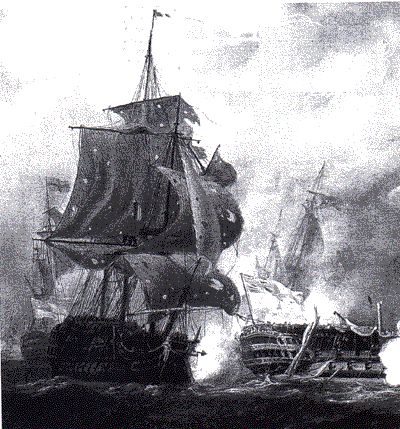 |
FAMOUS SHIPS |
 |
FAMOUS SHIPS |
The H.M.S.DEFENCE
This is the second part of the history
of this ships name, the first installment having appeared in the newsletter last
month, which told the history of the WWI modern Minotaur-class armored cruiser
H.M.S. DEFENCE. This installment is
going to tell the history of the Arrogant-class 3rd rate 74-gun
ship-of-the-line H.M.S. DEFENCE between the years 1763 through 1811.
 She was launched in the last year of
the Seven Years’ war in 1763 from the Devonport Dockyard in England.
She was designed by Sir Thomas Slade.
Her dimensions were: Length,
168 feet; Breadth, 46 feet 8 inches; Depth, 19 feet 8 inches, Tons, 1,630.
She had a compliment of 530 men. She
was armed with 28 X 32 pounders on her lower deck, 28 X 18 pounders on her
middle deck and 18 X 9 pounders on her upper deck.
She was the first ship with the name of H.M.S. DEFENCE and the most
decorated.
She was launched in the last year of
the Seven Years’ war in 1763 from the Devonport Dockyard in England.
She was designed by Sir Thomas Slade.
Her dimensions were: Length,
168 feet; Breadth, 46 feet 8 inches; Depth, 19 feet 8 inches, Tons, 1,630.
She had a compliment of 530 men. She
was armed with 28 X 32 pounders on her lower deck, 28 X 18 pounders on her
middle deck and 18 X 9 pounders on her upper deck.
She was the first ship with the name of H.M.S. DEFENCE and the most
decorated.
She did not see much action for the
first two decades of her existence, as there was a relative time of peace during
this period. But thereafter, her
record of battles and actions she was involved with and fought in include most
of the major engagements of the Franco-British contest for supremacy of the
seas. He first major engagement was
with Rodney at the Moonlight Battle off St. Vincent in 1780, when she was one of
the leading ships in the general chase that followed this victory.
In1782, when she was with the fleet of Admiral Sir Edward Hughes.
She fought in the battle of Cuddalore, India (a subsidiary theater of the
American Revolution) against Admiral Pierre de Suffren de St. Tropez.
This was the third naval battle between the British admiral Hughes and
the French admiral de Suffren in the Bay of Bengal.
The battle lasted for several hours with the French inflicting more
damage on the British ships, but at a higher casualty rate.
There was no clear winner in this battle, both fleets being damaged.
This was followed up in 1795 with her
involvement in the battle of the Glorious First of June, when as part of Admiral
Lord Howe’s Channel Fleet she managed to break the French line under Admiral
Villaret-Joyeuse. At this battle
she fought her most obstinate contest. H.M.S.
DEFENCE, under Captain J. Gambier, fought the JACOBIN of 110 guns.
They were in close action for up to 3 hours, the end result being that
the JACOBIN sank! H.M.S. DEFENCE
was very badly damaged and had to be towed from the line of battle by the
frigate PHAETON. The fight was so
fierce that even though the JACOBIN was sinking, her crew refused to surrender
and actually fought the upper deck guns with the water running around the
ankles, their French colors having been nailed to the mast.
On February 14, 1797, H.M.S. DEFENCE
was with Admiral Sir John Jervis’s Mediterranean Fleet when it engaged the
Spanish fleet under Admiral Don Jose de Cordoba at the Battle of Cape St.
Vincent. The following year she was
part of the fleet of Rear Admiral Horatio Nelson involved in the Battle of the
Nile (August 1, 1798). Three years
after that she was involved, again with Admiral Nelson, in the Battle of
Copenhagen on April 2, 1801.
Under Captain George Hope, H.M.S.
DEFENCE sailed in Admiral Collingwood’s lee column at the Battle of Trafalgar
on October 21, 1805. She engaged
the French BERWICK and forced the surrender of the Spanish SAN ILDEFONSO, the
latter having 165 dead and wounded to her own 36.